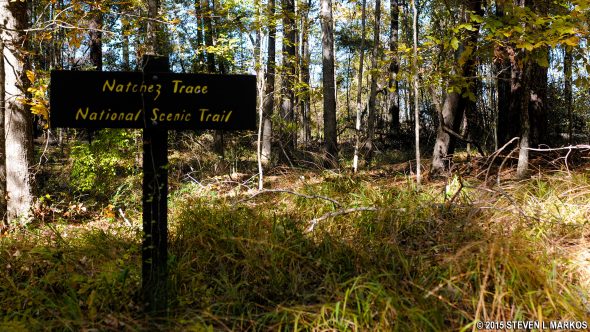The Natchez Trace National Scenic Trail is comprised of five discontiguous trail segments, all of which can be accessed at parking areas along or near the Natchez Trace Parkway, a 444-mile road that runs from Natchez, Mississippi, to Nashville, Tennessee. Overall, there are approximately 60 miles of trail with sections ranging from 3 to 25 miles in length. In some cases the trails follow the original Natchez Trace—an early American foot trail that eventually became one of the nation’s first National Roads—but mohttps://npplan.com/national-historic-trails/natchez-trace-parkway-park-at-a-glance/st are comprised of newly formed hiking trails that follow the Natchez Trace Parkway. The trail is open to hikers and, on most segments, horseback riders. No bikes are allowed. For more information on the Natchez Trace and Natchez Trace Parkway, see the History of the Natchez Trace Parkway.
I hiked a portion of the Natchez Trace National Scenic Trail in all five areas, but because all segments are out-and-back trails, I did not hike the entire trail system. Even the shortest 3-mile trail becomes a 6-mile hike. And since camping is not allowed along the trail, hiking the longer segments is impractical unless you have a ride waiting at one end. On a trail such as the Appalachian Trail (also an National Scenic Trail), you can hike 15 miles in a day and camp at night at designated campsites, then continue the next day. Thus, unlike the traditional National Parks where I bring you detailed information, I can only report on a few miles of the 60-mile trail system.
With that said, I do not have the highest opinion of the Natchez Trace National Scenic Trail. I found some segments to be completely overgrown, some even disappearing into thin air. Others have unmarked and/or unmapped intersections that lead to confusion as to which way to go. Furthermore, the trail follows the Natchez Trace Parkway, and with the road sometimes within view and the traffic noise often present, there’s nothing really scenic about it. You might as well just hike fifty yards into the woods and start bushwhacking your way north or south along the same route as the road.
To be fair, there are some enjoyable sections. The Potkopinu Trail follows the original Natchez Trace and appears to be navigable, though often debris strewn. The most northern section, the Highland Rim trail, was fun and challenging. However, I found the Rocky Springs Trail and Blackland Prairie Trail poorly marked, and I got very confused on both. The worst of the bunch is the Yockanookany Trail, which seems to be completely derelict. I came in contact with it three times and had negative experiences all three times. Again, I want to make it clear that I only hiked a few miles of the trail, and for all I know the other sections could be hiker paradises. Even the unruly sections may well be cleared by the time you do your hiking. Thus, take any negative reviews with a grain of salt, but do realize that I have accurately portrayed the trail segments that I did hike. It is up to you to explore the rest of the trail.
I have provided parking information plus trail reviews and a few photographs from my hikes of the five trail segments. Mile posts numbers are in reference to Natchez Trace Parkway mile posts.
Potkopinu Segment (Mile Posts 17-20)
Rocky Springs Segment (Mile Posts 52.4 – 59)
Yockanookany Segment (Mile Posts 108-131)
Blackland Prairie Segment (Mile Posts 260.8 – 266)
Highland Rim Segment (Mile Posts 407.9 – 427.4)
The Natchez Trace National Scenic Trail is run by the Natchez Trace Parkway. For more information call the Parkway Visitor Center in Tupelo, Mississippi, at 1-800-305-7417. You can also visit the website of the Natchez Trace Parkway Association, a non-profit organization that helps raise money to maintain the Natchez Trace Parkway and the National Scenic Trail.
With a few exceptions, use of any photograph on the National Park Planner website requires a paid Royalty Free Editorial Use License or Commercial Use License. See the Photo Usage page for details.
Last updated on December 13, 2021




